
You’re standing on the first tee of your local golf course, nervously gripping your driver as your more experienced playing partner shouts “Good luck avoiding the bogey man!” You nod politely, but inside you’re wondering:
what exactly is a bogey in golf, and should you be worried about this mysterious ‘bogey man’? Understanding official golf terminology is crucial for every player. Understanding golf scoring starts with knowing what par means in golf.
What does bogey mean in golf for beginners? In golf, a bogey is when you complete a hole in one stroke more than par. For example, if you take 5 strokes on a par-4 hole, you’ve scored a bogey.
While professional golfers try to avoid bogeys, they’re actually a reasonable target for beginners learning golf fundamentals and represent solid, respectable golf according to USGA scoring guidelines.
Understanding bogeys is crucial for every golfer’s journey because they serve as a realistic scoring benchmark and help you track your improvement over time through your golf handicap.
Let’s explore everything you need to know about bogeys, their fascinating history, and how they fit into your golf development.
What is a Bogey in Golf? (Quick Definition)
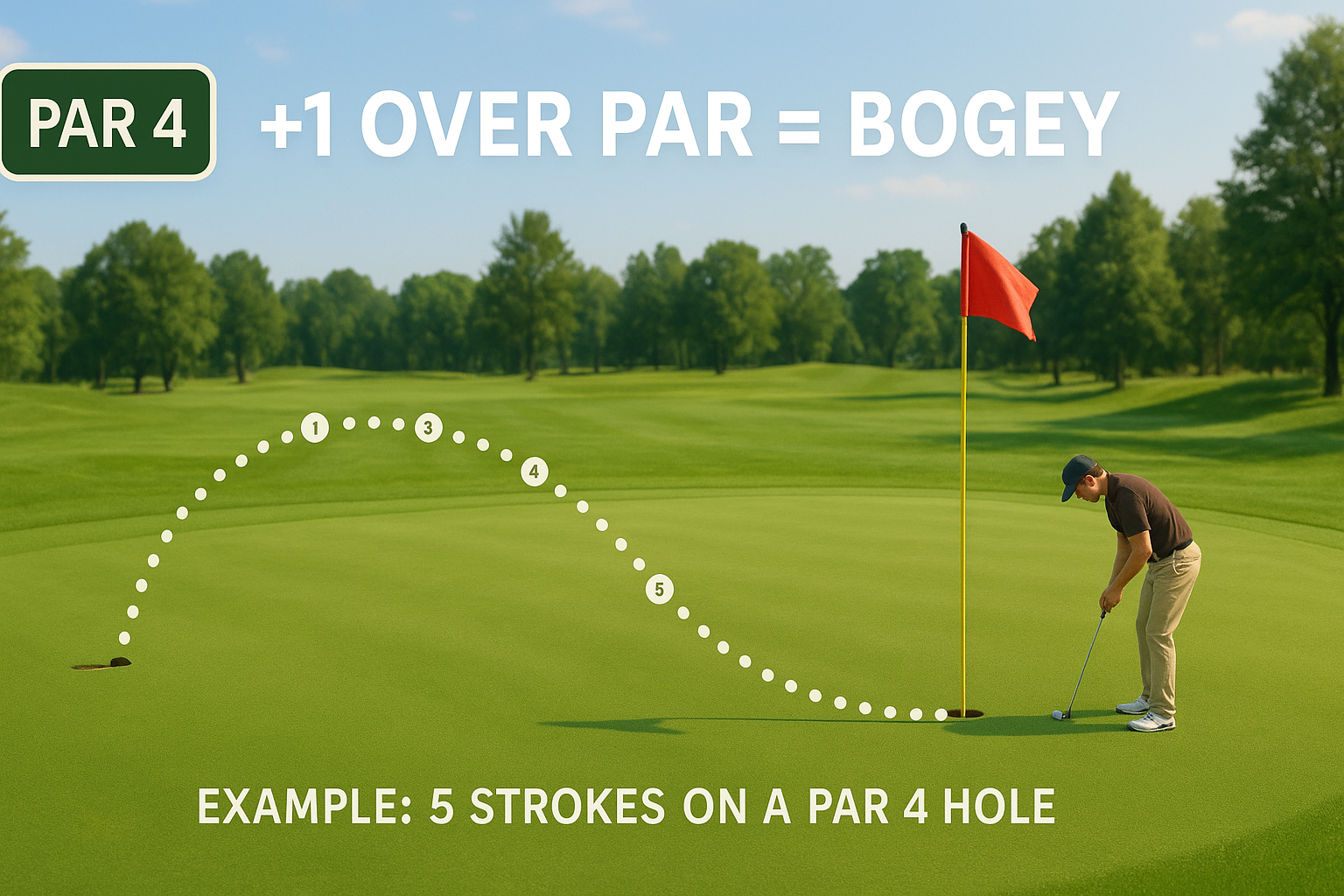
A bogey is one stroke over par on any golf hole. Here’s how it works for each hole type:
- Par-3 hole: 4 strokes = bogey
- Par-4 hole: 5 strokes = bogey
- Par-5 hole: 6 strokes = bogey
What’s a bogey in golf? Simply put, it’s the score you get when you need one extra shot beyond what an expert golfer would typically take to complete the hole, as defined by the R&A and USGA Rules of Golf using proper golf swing technique.
This happens more often than you might think – even scratch golfers (0 handicap) make bogey or worse on 44% of holes they play, according to National Golf Foundation.
The term applies to individual holes, not entire rounds. If you make bogey on every hole of a par-72 course, you’d shoot 90 – which is actually considered bogey golf and represents a significant achievement for many recreational players working to improve their handicap.
The Fascinating History of the Golf Bogey
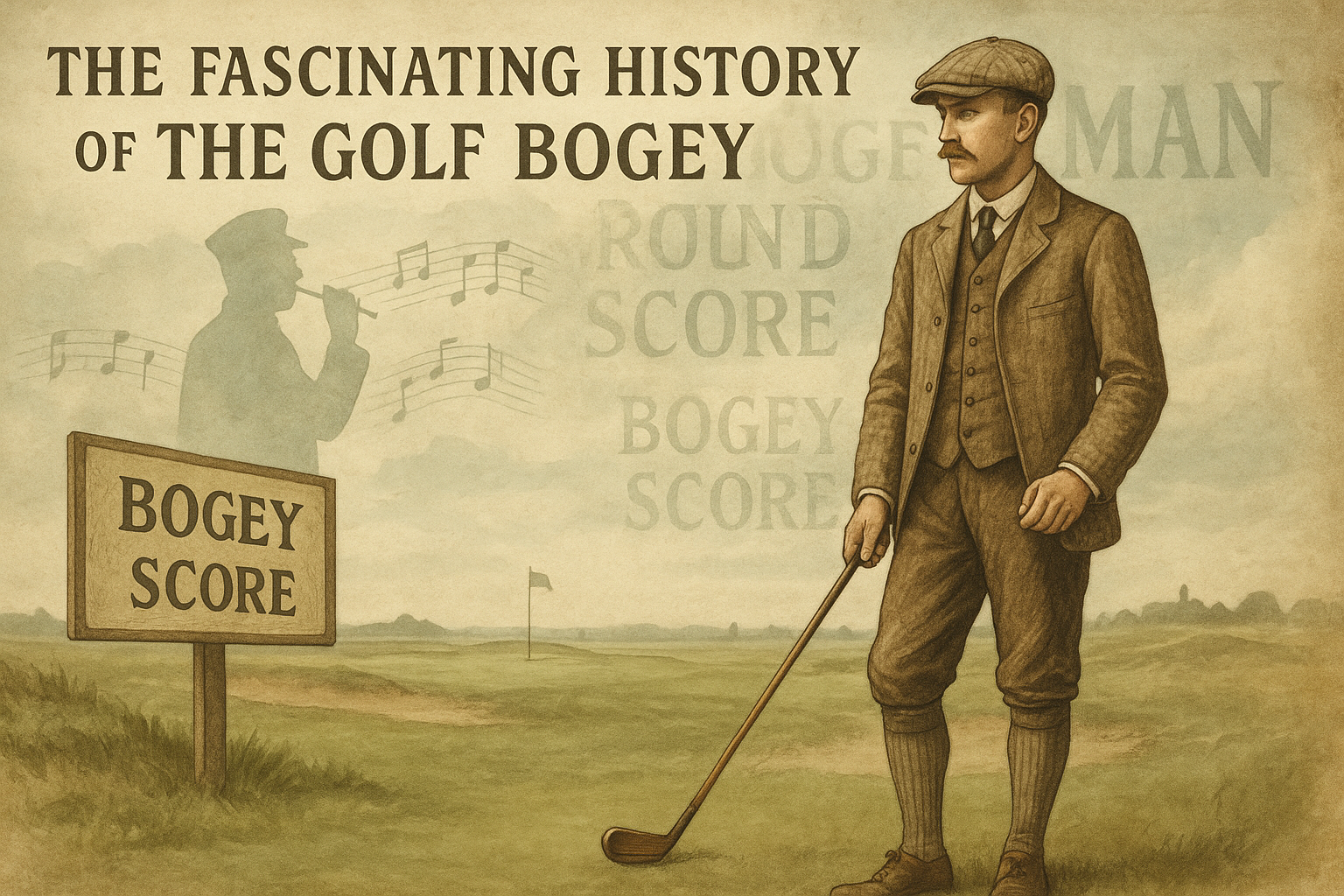
The story of how “bogey” got its name is one of golf’s most entertaining etymological tales. In 1890, at Great Yarmouth Golf Club in England, one of the historic clubs that shaped modern golf terminology, the term was born from an unlikely source – a popular music hall song.
Hugh Rotherham, secretary of Coventry Golf Club, had developed the concept of a “ground score” – the number of strokes a good golfer should take on each hole – what we now call par.
When Dr. Thomas Browne, secretary of Great Yarmouth Club, adopted this idea, a member named Charles Wellman (possibly Major Wellman) exclaimed during a match: “This player of yours is a regular bogey man!”
This was a reference to the popular song “Hush! Hush! Hush! Here Comes the Bogey Man,” which featured the lyric “I’m the Bogey Man, catch me if you can”. The name stuck, and golfers began playing against this imaginary “Mister Bogey.”
The term evolved further in 1892 when Colonel Seely-Vidal at the United Services Club at Gosport felt that military officers shouldn’t compete against a mere “Mister” Bogey, so he was promoted to “Colonel Bogey”.
This character became so embedded in golf culture that the famous ‘Colonel Bogey March’ was written, forever cementing the term in golf history, forever cementing the term in golf history.
Originally, bogey represented what we now call par – the score a skilled golfer should achieve. It wasn’t until the USGA began using ‘par’ as the standard in 1911 that bogey shifted to mean one stroke over par.Is a Bogey Good or Bad in Golf?
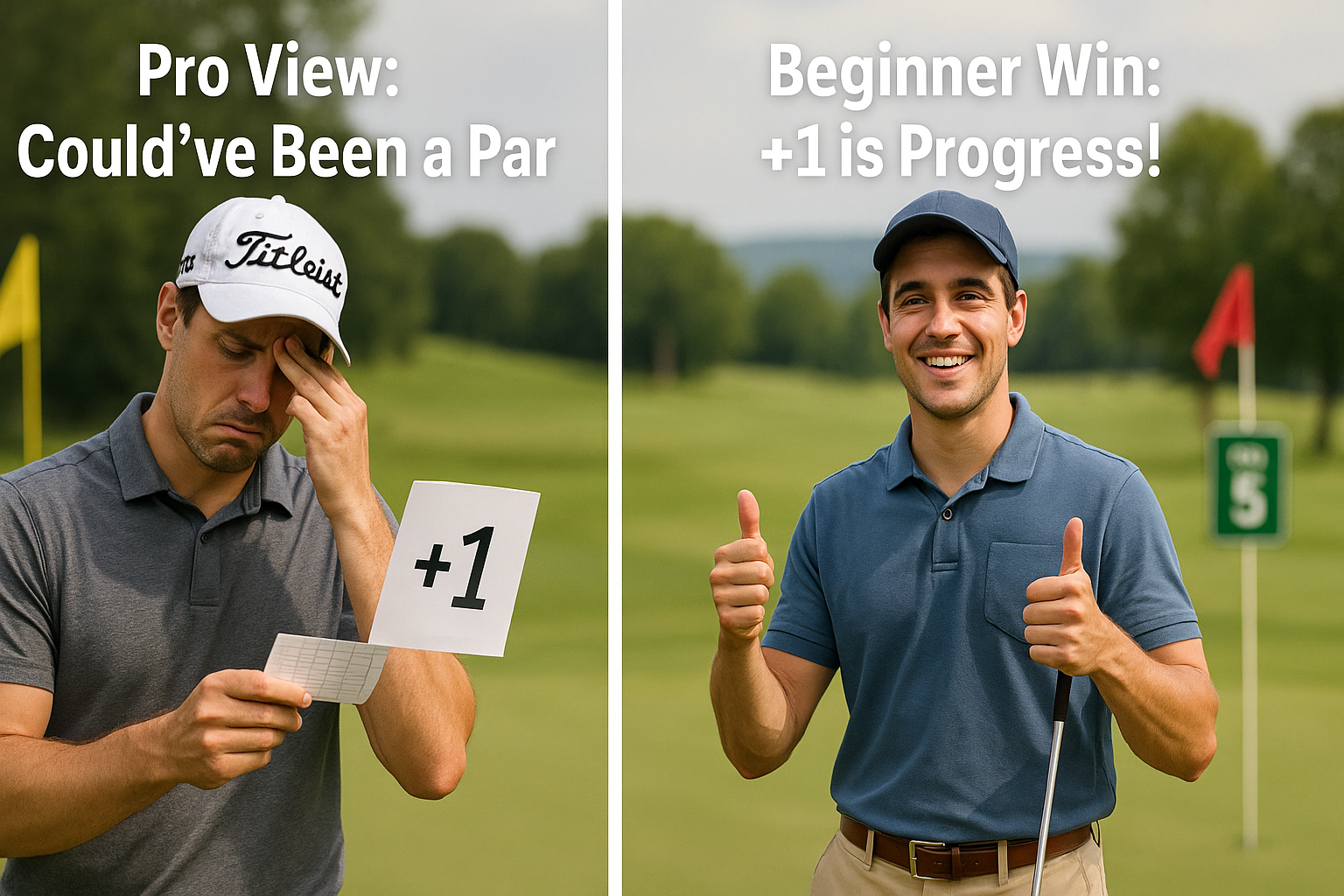
Is bogey good or bad in golf? The answer depends entirely on your skill level and perspective. For beginners and amateur golfers, bogeys represent solid, respectable golf that many players aspire to achieve consistently.
For Professional Golfers
Professional golfers view bogeys as minor setbacks. They aim to score at or below par on every hole, so a bogey represents a missed opportunity. However, even the best players in the world make bogeys regularly.
PGA Tour players averaged 2.62 bogeys per round in tournament play, according to official PGA Tour statistics.
For Average Golfers (15-20 Handicap)
For golfers in the 15-20 handicap range, bogeys are a normal part of the game. These players typically make 7.3 bogeys per round, data supported by GHIN handicap system analysis“, along with 4.7 double bogeys and 2.1 triple bogeys or worse.
Bogey golf means you’re playing at an 18-handicap level, which puts you in the upper portion of recreational golfers.
For Beginners
Is a bogey a bad score? Not for beginners! If you’re new to golf and can consistently make bogeys, you’re doing exceptionally well. As one Reddit user perfectly summarized: “Bogey golf is closer to being a scratch golfer than it is to being a beginner golfer“.

Understanding Different Types of Bogeys
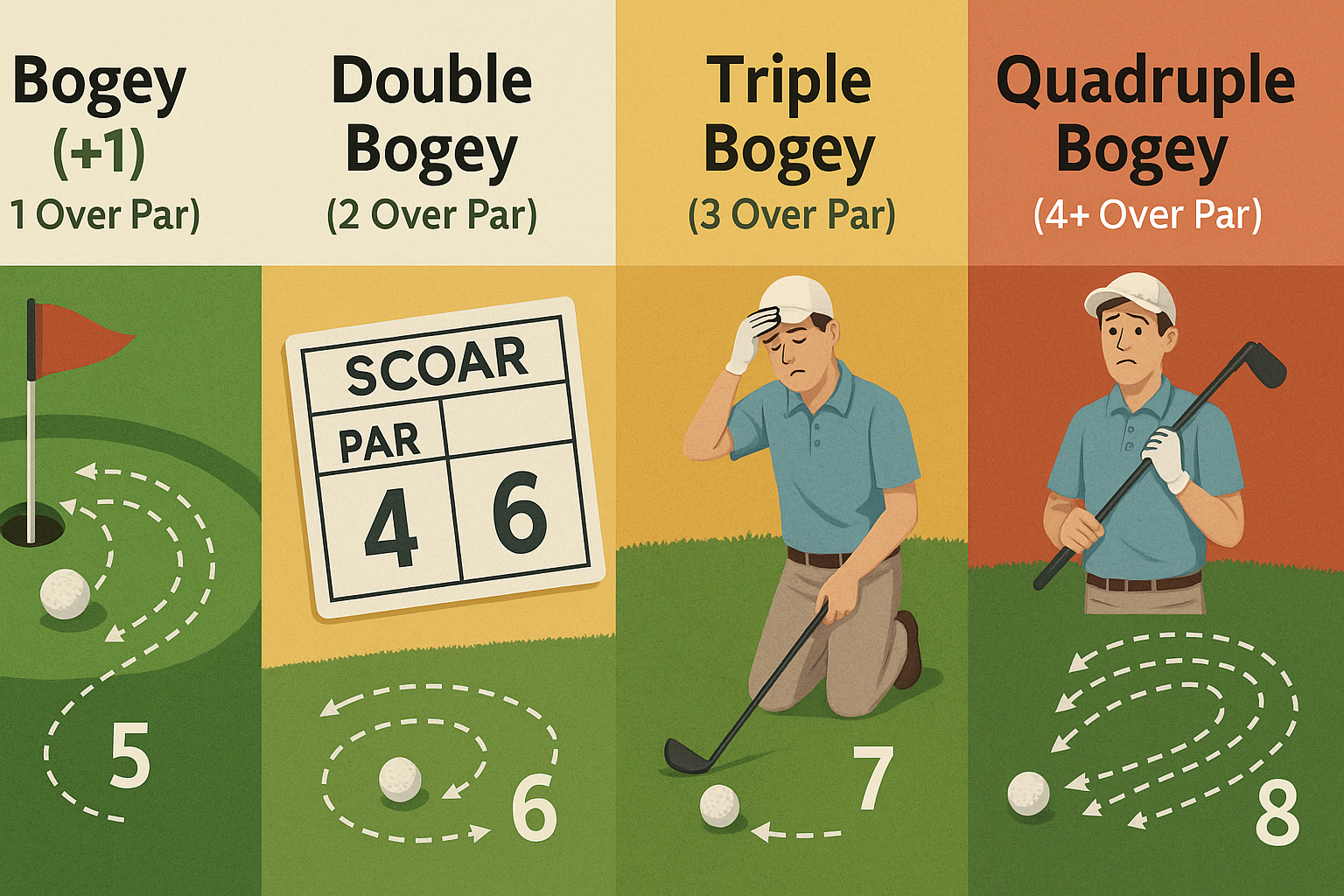
Golf’s scoring system extends beyond the simple bogey to include several variations, each representing additional strokes over par:
Double Bogey (2 over par)
A double bogey occurs when you take two strokes more than par on a hole. Examples include:
- 5 strokes on a par-3 hole
- 6 strokes on a par-4 hole
- 7 strokes on a par-5 hole
Double bogeys are where scores really start to climb, as confirmed by Golf Digest performance studies, often caused by poor golf swing fundamentals. A 15-handicap golfer makes nearly five double bogeys per round, making these the scores to focus on eliminating.
Triple Bogey (3 over par)
A triple bogey represents three strokes over par. While less common than doubles, these ‘disaster holes’ can quickly derail a good round, especially when course management breaks down. Many golfers refer to triples as the beginning of “big numbers” that are difficult to recover from.
Quadruple Bogey and Beyond
A quadruple bogey is four strokes over par, and scores beyond this are often called “disaster holes” or “blowups.” Even tour professionals occasionally face these challenging scores – Rory McIlroy famously started the 2019 Open Championship with a quadruple bogey 8 on the first hole.
Bogey vs Par vs Birdie: Golf Scoring Explained
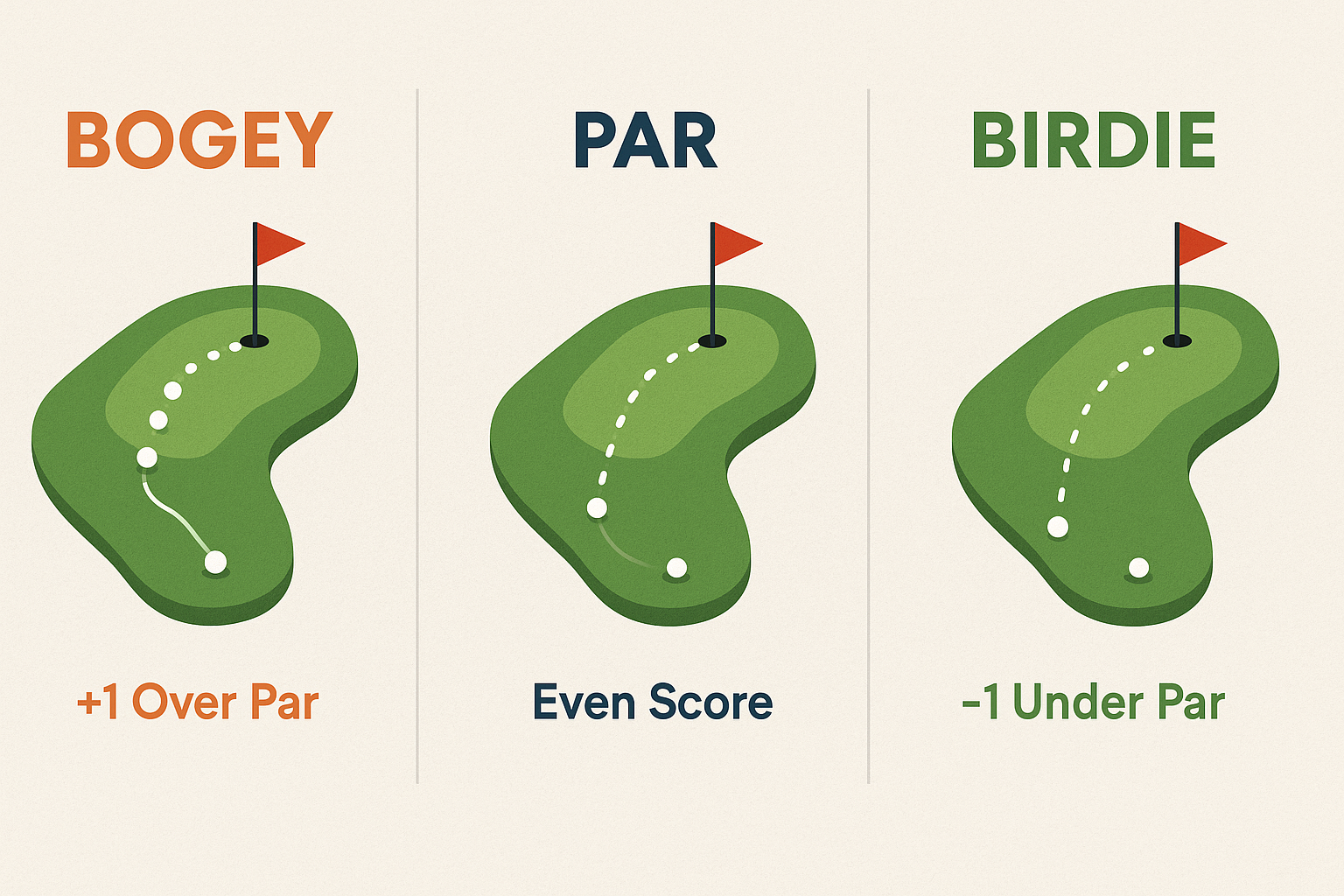
Understanding golf’s scoring system helps put bogeys in proper perspective, especially when learning what par means. Here’s a complete breakdown:
| Score | Strokes vs Par | Par-3 Example | Par-4 Example | Par-5 Example |
|---|---|---|---|---|
| Birdie | -1 | 2 strokes | 3 strokes | 4 strokes |
| Par | 0 | 3 strokes | 4 strokes | 5 strokes |
| Bogey | +1 | 4 strokes | 5 strokes | 6 strokes |
| Double Bogey | +2 | 5 strokes | 6 strokes | 7 strokes |
| Triple Bogey | +3 | 6 strokes | 7 strokes | 8 strokes |
What does bogey mean in golf? In the context of this scoring system, it represents the first level above par – a manageable “mistake” that doesn’t devastate your round like double bogeys and worse.
Other important scoring terms include:
- Eagle: 2 strokes under par, as defined by golf’s governing bodies (learn more about birdies and eagles)
- Albatross/Double Eagle: 3 strokes under par
- Hole-in-One/Ace: 1 stroke on any hole
How Common Are Bogeys in Golf?
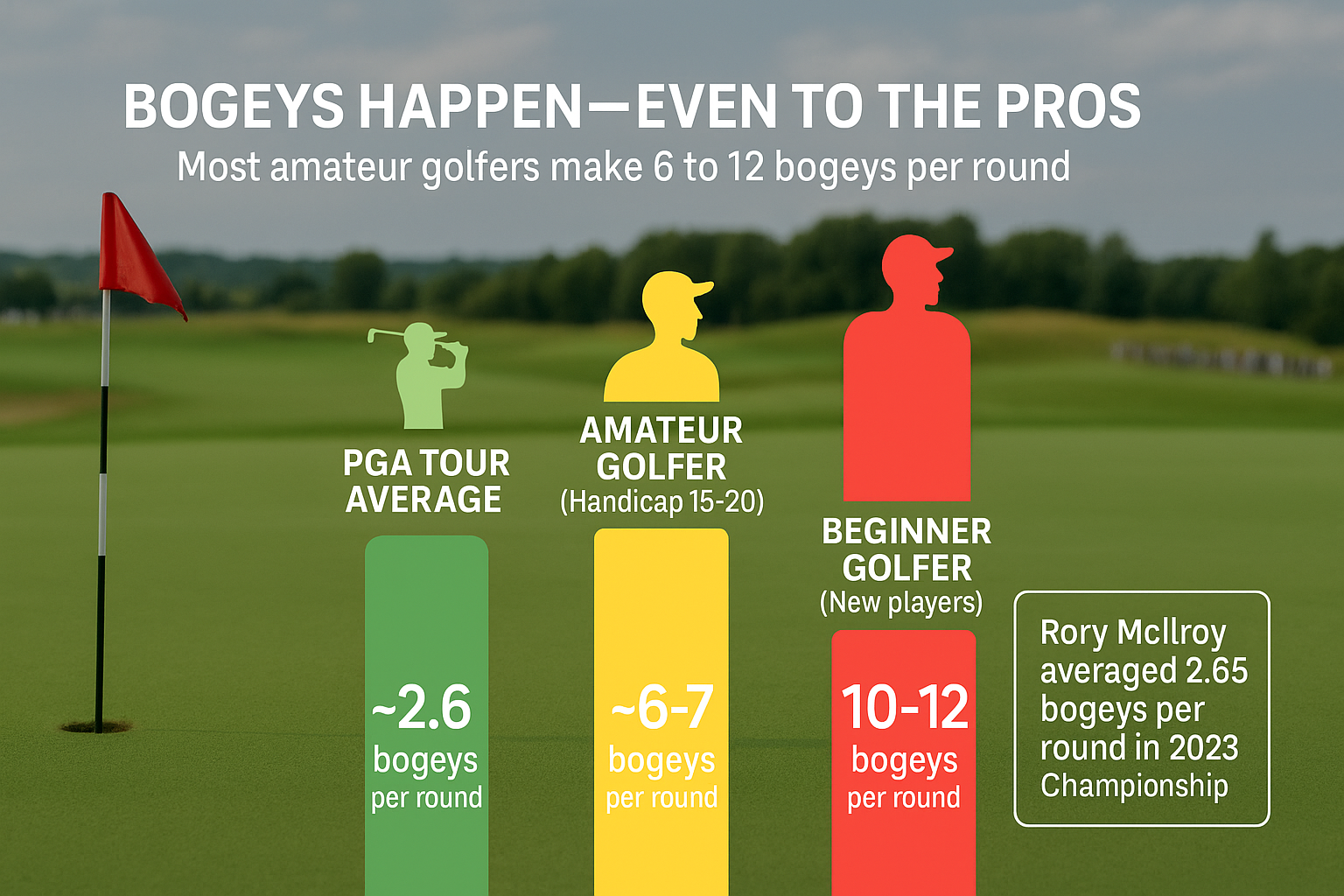
Bogeys are incredibly common across all skill levels. Even the world’s best players make them regularly:
Professional Statistics
- PGA Tour average: 2.62 bogeys per round, tracked by official PGA Tour ShotLink data
- Scottie Scheffler (world #1): 11.11% bogey avoidance rate according to Official World Golf Ranking data, meaning he makes bogeys on about 15-16% of holes
- Even scratch golfers score bogey or worse on 44% of holes, showing the importance of consistent golf fundamentals
Amateur Golfer Statistics
According to comprehensive data from MyGolfSpy and TheGrint, validated by National Golf Foundation analyzing thousands of rounds:
- 5-handicap golfers: 6.4 bogeys per round (44% of holes)
- 10-handicap golfers: 7.7 bogeys per round
- 15-handicap golfers: 7.3 bogeys per round
- 20-handicap golfers: 6.8 bogeys per round (but with many more double bogeys)
Notable Bogey-Free Records
The longest bogey-free streak in professional golf belongs to Jin Young Ko, who played 114 consecutive holes without a bogey in 2019, as reported by the LPGA Tour, breaking Tiger Woods’ previous record of 110 holes set in 2000.
Lee Trevino holds the distinction of being the only golfer to win a PGA Tour event without making a bogey (1974 Greater New Orleans Open) without making a single bogey over 72 holes – a feat matched only by J.T. Poston in 2019.
5 Tips to Avoid Bogeys (Improve Your Golf Game)

While bogeys are normal, minimizing them is key to lower scores. Here are proven strategies from golf professionals:
Master Your Tee Shots
Accurate driving is essential for avoiding bogeys, starting with proper golf swing technique. Focus on:
- Hitting fairways over maximum distance
- Using course management to avoid hazards
- Choosing clubs that give you the best chance of finding the short grass
- Playing from tees appropriate for your skill level and handicap
Improve Your Putting
Three-putting accounts for 25-40% of double bogeys, according to Golf Digest instruction research. Develop:
- A consistent pre-shot routine starting with proper golf grip
- Better lag putting from long distances
- The ability to make putts inside 6 feet
- Speed control to avoid leaving yourself difficult second putts
Avoid Hazards and Trouble
Smart course management prevents disaster holes, a principle taught by PGA of America professionals, especially during longer rounds of 18 holes:
- Aim for the center of greens rather than pins
- Take conservative routes around water and sand
- When in trouble, play back to safety rather than attempting hero shots
- Accept bogeys rather than risking double bogeys or worse
Practice Course Management
Think strategically about each hole based on par values and pin positions:
- Plan your approach before teeing off
- Consider where misses will leave you
- Play to your strengths and avoid your weaknesses
- Use the “10% rule” – aim for targets 10% of the putt’s length from the hole
Work on Your Short Game
Short game excellence saves pars and bogeys, turning potential disasters into manageable scores or even birdies:
- Practice chipping and pitching regularly
- Learn to get up and down from around the green
- Develop bunker play skills
- Focus on distance control with wedges and understanding golf ball performance
Bogey Golf: What Does it Mean?
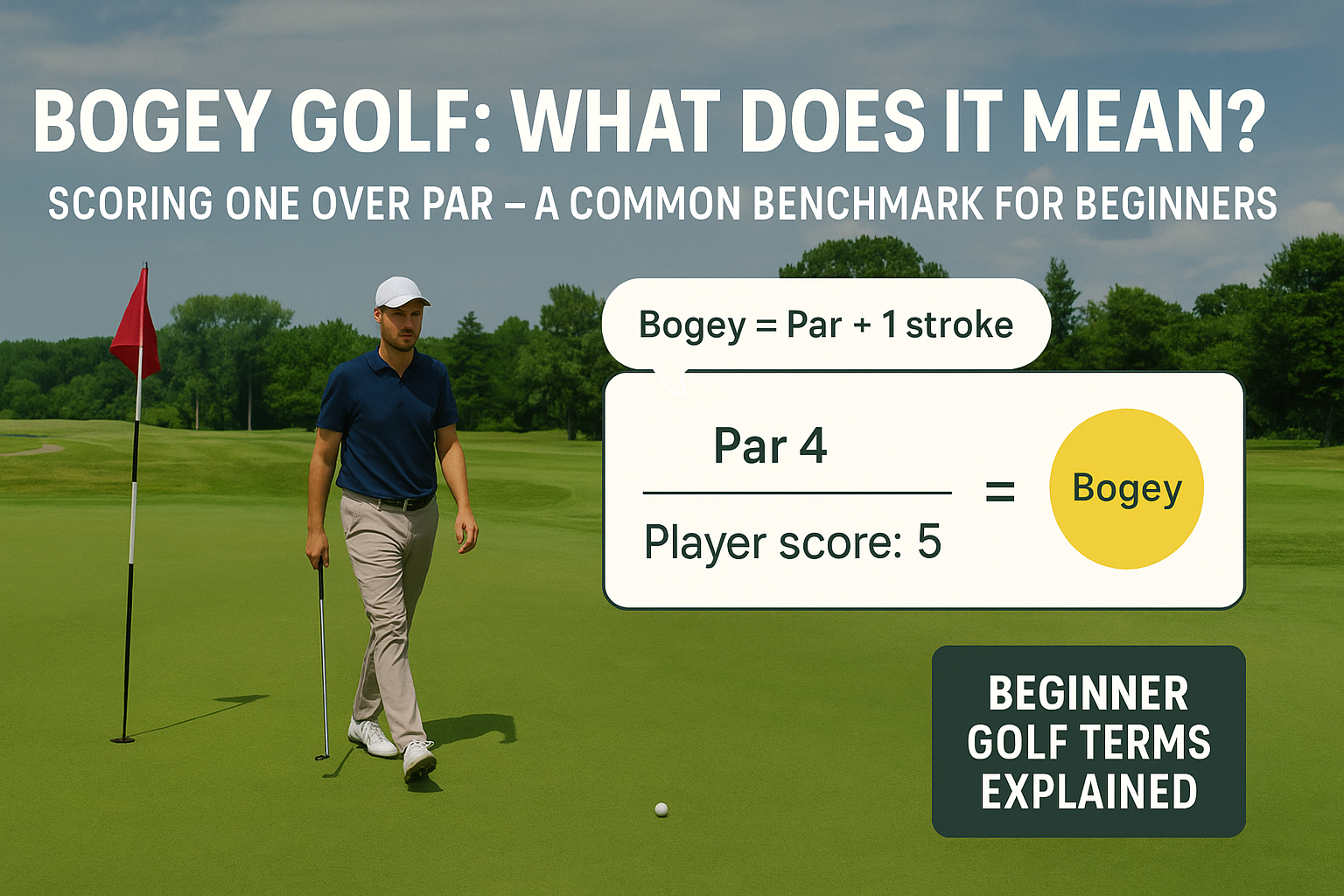
Bogey golf refers to averaging one stroke over par on every hole, resulting in a score of 90 on a par-72 course. A bogey golfer is officially defined by the USGA handicap system as a male golfer with a handicap index around 20.0, or a female golfer with an index around 24.0.
What Bogey Golf Looks Like
A typical bogey golfer’s round includes:
- 4 pars
- 11 bogeys
- 2 double bogeys
- 1 triple bogey
Time to Become a Bogey Golfer
How long does it take to become a bogey golfer? For beginners who practice consistently, it typically takes 6-12 months to reach bogey golf level, though some sources suggest 3-5 years for sustained improvement.
Factors affecting this timeline include:
- Frequency of practice and play
- Quality of instruction in golf fundamentals
- Natural athletic ability
- Course management skills
Conclusion: Embrace Your Golf Journey
Understanding bogeys is fundamental to enjoying and improving your golf game. For beginners, bogeys represent solid, respectable golf that many players aspire to achieve consistently. Rather than viewing them as failures, embrace bogeys as stepping stones on your golfing journey.
Key Takeaways
- Bogeys are one stroke over par and completely normal for all skill levels
- Even professional golfers make 2-3 bogeys per round on average
- Bogey golf (shooting 90) is a significant achievement for recreational players
- The key to improvement is avoiding double bogeys and worse through better course management and fundamentals
- Course management and smart play prevent disaster holes more than perfect technique
Final Thoughts
Whether you’re just starting your golf journey or working to break 90, remember that every great golfer has made thousands of bogeys.
Focus on steady improvement, enjoy the process, and consider working with a PGA certified professional for personalized guidance, and celebrate those moments when you turn a potential double bogey into a manageable bogey.
Ready to work on your bogey avoidance? Start by practicing your short game, developing better course management skills recommended by Golf Digest’s top instructors, and maintaining clean, well-maintained equipment, and playing from tees that match your abilities.
With patience and practice, you’ll find yourself making fewer bogeys and more pars as your golf game continues to improve.
Ready to track your progress and optimize your equipment? Use our comprehensive guides on golf club setup and learn how long it takes to play 9 or 18 holes to better manage your practice time.


